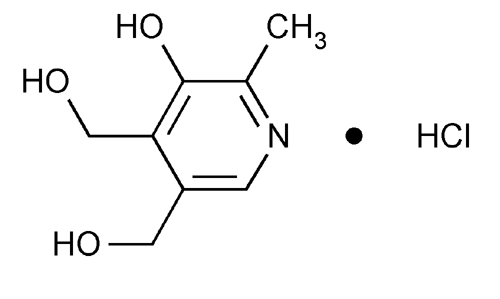Pyridoxine Hydrochloride
3,4-Pyridinedimethanol, 5-hydroxy-6-methyl-, hydrochloride.
Pyridoxol hydrochloride
» Pyridoxine Hydrochloride contains not less than 98.0 percent and not more than 102.0 percent of C8H11NO3·HCl, calculated on the dried basis.
Packaging and storage—
Preserve in tight, light-resistant containers.
Loss on drying  731
731 —
Dry it in vacuum over silica gel for 4 hours: it loses not more than 0.5% of its weight.
—
Dry it in vacuum over silica gel for 4 hours: it loses not more than 0.5% of its weight.
Residue on ignition  281
281 :
not more than 0.1%.
:
not more than 0.1%.
Heavy metals, Method II  231
231 :
0.003%.
:
0.003%.
Chloride content—
Dissolve about 500 mg, accurately weighed, in 50 mL of methanol in a glass-stoppered flask. Add 5 mL of glacial acetic acid and 2 to 3 drops of eosin Y TS, and titrate with 0.1 N silver nitrate VS. Each mL of 0.1 N silver nitrate is equivalent to 3.545 mg of Cl. Not less than 16.9% and not more than 17.6% of Cl, calculated on the dried basis, is found.
Assay—
Mobile phase—
Mix 20 mL of glacial acetic acid, 1.2 g of sodium 1-hexanesulfonate, and about 1400 mL of water in a 2000-mL volumetric flask. Adjust with glacial acetic acid or 1 N sodium hydroxide to a pH of 3.0. Add 470 mL of methanol, dilute with water to volume, mix, and filter through a 0.5-µm filter. Make adjustments if necessary (see System Suitability under Chromatography  621
621 ).
).
Internal standard solution—
Dissolve p-hydroxybenzoic acid in Mobile phase to obtain a solution having a concentration of 5 mg per mL.
Standard preparation—
Dissolve about 50 mg of USP Pyridoxine Hydrochloride RS, accurately weighed, in Mobile phase in a 100-mL volumetric flask, dilute with Mobile phase to volume, and mix. Transfer 10.0 mL of the resulting solution to a 100-mL volumetric flask, add 1.0 mL of Internal standard solution, dilute with Mobile phase to volume, and mix to obtain a solution having a known concentration of about 0.05 mg per mL.
Assay preparation—
Dissolve about 50 mg of Pyridoxine Hydrochloride, accurately weighed, in Mobile phase in a 100-mL volumetric flask, dilute with Mobile phase to volume, and mix. Transfer 10.0 mL of the resulting solution to a 100-mL volumetric flask, add 1.0 mL of Internal standard solution, dilute with Mobile phase to volume, and mix.
Chromatographic system
(see Chromatography  621
621 )—The liquid chromatograph is equipped with a 280-nm detector and a 4.6-mm × 25-cm column that contains packing L1. The flow rate is about 1.5 mL per minute. Chromatograph the Standard preparation, and record the peak responses as directed for Procedure: the resolution, R, of the pyridoxine and p-hydroxybenzoic acid peaks is not less than 2.5, and the relative standard deviation for replicate injections is not more than 3.0%.
)—The liquid chromatograph is equipped with a 280-nm detector and a 4.6-mm × 25-cm column that contains packing L1. The flow rate is about 1.5 mL per minute. Chromatograph the Standard preparation, and record the peak responses as directed for Procedure: the resolution, R, of the pyridoxine and p-hydroxybenzoic acid peaks is not less than 2.5, and the relative standard deviation for replicate injections is not more than 3.0%.
Procedure—
Separately inject equal volumes (about 20 µL) of the Standard preparation and the Assay preparation into the chromatograph, record the chromatograms, and measure the responses for the major peaks. The relative retention times are about 0.7 for pyridoxine and 1.0 for p-hydroxybenzoic acid. Calculate the quantity, in mg, of C8H11NO3·HCl in the portion of Pyridoxine Hydrochloride taken by the formula:
1000C(RU / RS)
in which C is the concentration, in mg per mL, of USP Pyridoxine Hydrochloride RS in the Standard preparation, and RU and RS are the ratios of the peak responses of pyridoxine to internal standard obtained from the Assay preparation and the Standard preparation, respectively.
Auxiliary Information—
Please check for your question in the FAQs before contacting USP.
Chromatographic Column—
| Topic/Question | Contact | Expert Committee |
| Monograph | Curtis Phinney
1-301-816-8540 |
(DSN05) Dietary Supplements - Non-Botanicals |
| Reference Standards | Lili Wang, Technical Services Scientist 1-301-816-8129 RSTech@usp.org |
USP32–NF27 Page 3451
Chromatographic columns text is not derived from, and not part of, USP 32 or NF 27.
